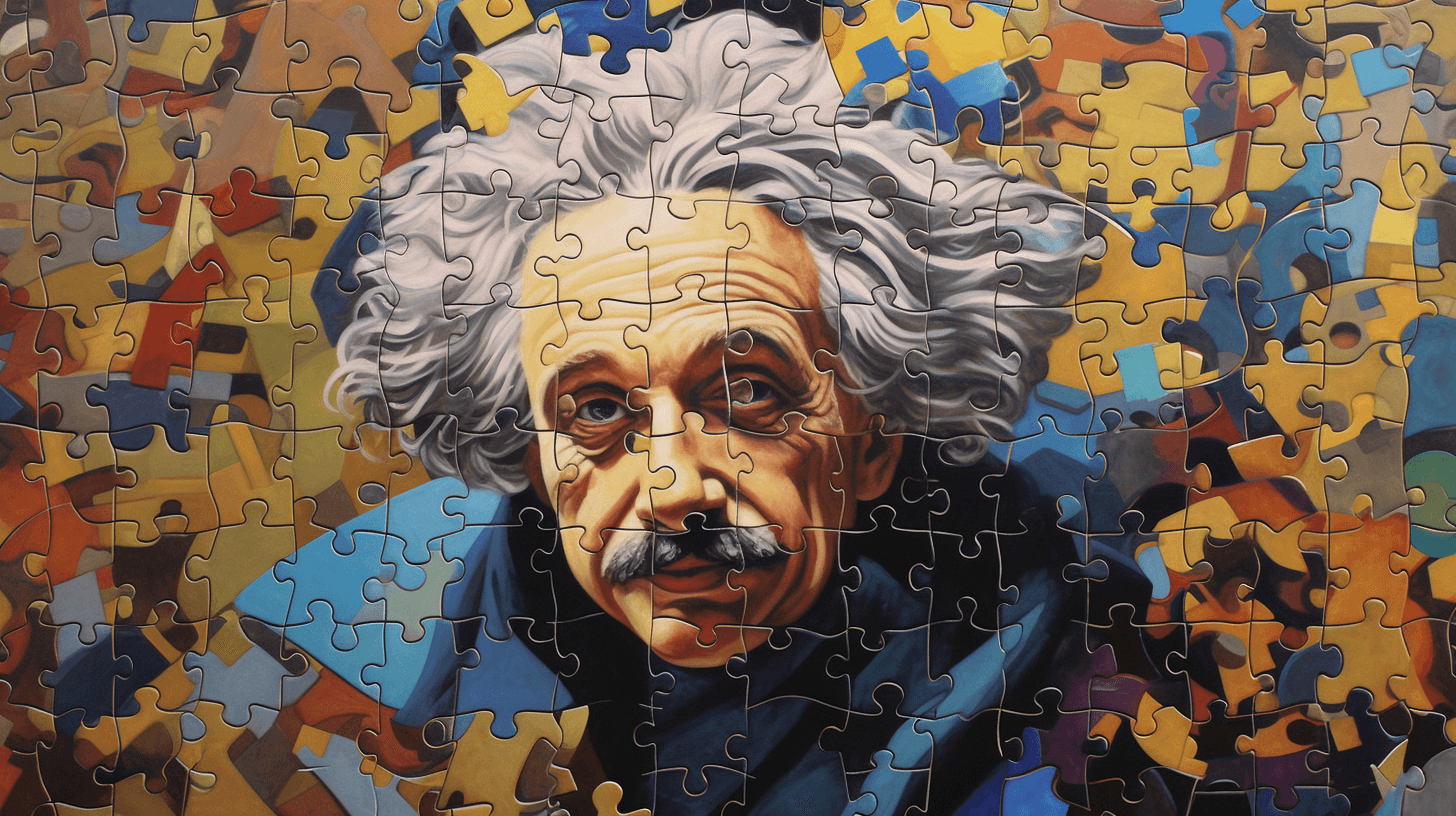📰 😲 With a New, Improved ‘Einstein,’ Puzzlers Settle a Math Problem 📏🧠
Da brah! Dese tiling lovers wen find da shape dey was dreamin’ ’bout. An’ now, dey stay one hund’ed percent shua!
Back in March, da mathematicians dat love dem tiles wen announce dey solved one puzzle: Dey wen find one “einstein” – one kine shape dat can tile up one infinite two-dimensional flat ting, but no make da same pattern ova an’ ova. “I neva expec’ fo make one big discovery,” David Smith, da guy dat wen start all dis, wen say. 🎉
Mr. Smith an’ his buddies wen give da einstein dey found da name “da hat.” Da word “einstein” come from da German word “ein stein,” dat mean “one stone,” o’ mo’ loose, “one tile” o’ “one shape.” Dis hat wen show up on Jimmy Kimmel, wen become one shower curtain, one quilt, one soccer ball, an’ even one cookie cutter. An’ da big Hatfest stay goin’ down at da University of Oxford dis July. 🎩🎉
“Who woulda tink dis lil’ polygon could cause so much commotion?” Marjorie Senechal, one mathematician from Smith College dat stay goin’ talk at da event, wen say. 😮
Da researchers coulda been happy wit’ dey discovery an’ all da excit’ment, an’ den call it pau. But Mr. Smith, from Bridlington in East Yorkshire, England, dat stay known as one guy dat stay always tinkin’ up new stuff, no could let go. Now, two months afta, da team wen top dey own selves wit’ one improved einstein. (No can find da papers fo’ bot’ discoveries in da peer review yet.) 🤔
Dis whole quest fo’ find dis kind tiling started back in da 1960s wen dis mathematician Hao Wang wen guess dat nobody goin’ find one set of shapes dat can tile one plane wit’out repeatin’. Den, his student Robert Berger, one retired electrical engineer from Lexington, Mass., wen go an’ find one set of 20,426 tiles dat do dat, an’ aftawards, one set of 104 tiles. By da 1970s, Sir Roger Penrose, one mathematical physicist from Oxford, wen bring ’em down to only two. 🧩
An’ den, wea da monotile hat come in. But dey had one lil’ issue.
Dr. Berger, an’ oddah people, wen point out dat da hat tiling use reflections – da tile shaped like one hat an’ its mirror image. “If you like fo’ be fussy, you can say, eh, no stay one set wit’ one tile, dat stay one set wit’ two tiles, an’ one just da reflection of da oddah,” Dr. Berger wen say.
“In some ways, dis question stay ’bout tiles as stuff we can hold an’ touch, not jus’ math ideas,” da authors wen write in da new paper. “You can take one hat made from papah o’ plastic an’ easily flip ’em ova fo’ see da reflection, but you no can do da same ting wit’ one glazed ceramic tile.”
Dis new monotile discovery no need reflections. An’ da researchers no need go far fo’ find ’em – dey say dis one stay “one close cousin of da hat.”
“I neva stay surprise dat one kine tile like dis stay exist,” Joseph Myers, one co-author an’ software developer from Cambridge, England, wen say. “But I neva ‘xpect dat get one dat stay so closely related to da hat.”
Originally, da team wen find out dat da hat stay part of one continuum dat can change shape – you can make da edges of da hat bigga’ o’ smalla’ – an’ make nonrepeating tilings wit’ reflections.
But den, dey find one “troublemaker” shape, dat technically called Tile (1,1). Dis shape stay like one version of da hat, but all sides da same length. An’ ’cause of dat, dis shape no can make one nonrepeating tiling. Instead, stay jus’ one simple pattern dat repeat. “Eh, fo’ real, dis one kine unreal dat dis shape wen get one secret superpower,” Dr. Kaplan, one co-author an’ computer scientist from da University of Waterloo, wen say. An’ dis superpower stay da key dat unlock da new discovery. 🧩🔓
Afta get inspired by Yoshiaki Araki from da Japan Tessellation Design Association in Tokyo, Mr. Smith wen start tinkin’ ’bout Tile (1,1) right afta dey wen post da first discovery online in March. “I wen cut out shapes from card an’ see wat goin’ happen if I use only tiles wit’ no reflections,” he wen say in one email. Da rule was no reflected tiles, “by order of da authors.”
Mr. Smith say, “No was long before I wen make one big patch” – he wen fit da tiles togetha’ like one jigsaw puzzle, no gaps o’ overlaps. He wen know he stay onto somethin’.
Den dey went deepah – wit’ plenny math tinkin’, drawing, an’ help from Dr. Kaplan an’ Dr. Myers using computers – da team wen prove dat dis tiling was really nonrepeating.
Dr. Kaplan wen explain on social media, “We call dis one ‘weakly chiral aperiodic monotile.’ It no repeat in one reflection-free world, but if you can use reflections, den it goin’ repeat.”
“Chiral” mean “handedness” – da Greek word “kheir,” dat mean “hand.” Dey wen call dis new nonrepeating tiling “chiral” ’cause stay only left- o’ right-handed tiles. “You no can mix da two,” Chaim Goodman-Strauss, one co-author an’ outreach mathematician from da National Museum of Mathematics in New York, wen say. 🧩✋
But da team no stop dea – dey wen take ’em one step furthah. Dey wen make one whole family of “strong o’ strictly chiral aperiodic monotiles” by changin’ da straight edges to curves.
Dey wen name ’em “Spectres” – dese monotiles, wit’ dey curvy shapes, on’y make nonrepeating tilings wit’out reflections. “One left-handed Spectre no can fit wit’ da mirror image of one right-handed Spectre,” Dr. Kaplan wen explain.
“Now, no can argue ’bout whethah da nonrepeating tile set get one o’ two tiles,” Dr. Berger wen say in one email. “Feel so good fo’ see one glazed ceramic einstein.”
Doris Schattschneider, one mathematician from Moravian University, wen say, “Dis mo’ like wat I woulda ‘xpected from one nonrepeating tile.” On one tiling listserv, she wen jus’ see one fun “Escherization” – like M.C. Escher, da Dutch artist – of da Spectre tile by Dr. Araki. He wen call ’em one “twinhead pig.”
“Dis no stay simple like da hat,” Dr. Schattschneider wen say. “Dis one real strange tile. Look like one mistake from nature.” 🎨🤪
NOW IN ENGLISH
📰 😲 With a New, Improved ‘Einstein,’ Puzzlers Settle a Math Problem 📏🧠
Wow! These tiling enthusiasts have found the shape they have been dreaming of. And now, they are a hundred percent sure!
Back in March, the mathematicians who love tiles announced that they solved a puzzle: They found an “einstein” – a shape that can tile an infinite two-dimensional plane without repeating the same pattern over and over. “I never expected to make such a big discovery,” David Smith, the person who started all this, said with excitement. 🎉
Mr. Smith and his friends gave the einstein they found the name “the hat.” The word “einstein” comes from the German word “ein stein,” which means “one stone” or more loosely, “one tile” or “one shape.” This hat showed up on Jimmy Kimmel, became a shower curtain, a quilt, a soccer ball, and even a cookie cutter. And the big Hatfest is happening at the University of Oxford this July. 🎩🎉
“Who would have thought this little polygon could cause so much commotion?” Marjorie Senechal, a mathematician from Smith College who will be speaking at the event, exclaimed in surprise. 😮
The researchers could have been happy with their discovery and all the excitement, and then called it a day. But Mr. Smith, from Bridlington in East Yorkshire, England, known as the person who is always thinking up new stuff, couldn’t let it go. Now, two months later, the team has topped themselves with an improved einstein. (The papers for both discoveries are not yet available in peer review.) 🤔
This whole quest to find this kind of tiling started back in the 1960s when mathematician Hao Wang speculated that nobody would find a set of shapes that can tile a plane without repeating. Then, his student Robert Berger, a retired electrical engineer from Lexington, Mass., went and found a set of 20,426 tiles that do that, and later, a set of 104 tiles. By the 1970s, Sir Roger Penrose, a mathematical physicist from Oxford, reduced it to only two. 🧩
And then, enters the monotile hat. But they had a little issue.
Dr. Berger and others pointed out that the hat tiling uses reflections – the tile shaped like a hat and its mirror image. “If you want to be precise, you can say that it is not a set with one tile, but a set with two tiles, and one is just the reflection of the other,” Dr. Berger explained.
“In some ways, this question is about tiles as physical objects that we can hold and touch, not just math ideas,” the authors wrote in the new paper. “You can take a hat made from paper or plastic and easily flip it over to see the reflection, but you can’t do the same thing with a glazed ceramic tile.”
This new monotile discovery doesn’t need reflections. And the researchers didn’t have to go far to find it – they say it is a “close cousin of the hat.”
“I was not surprised that a tile like this exists,” Joseph Myers, a co-author and software developer from Cambridge, England, said. “But I never expected to get one that is so closely related to the hat.”
Originally, the team found out that the hat is part of a continuum that can change shape – you can make the edges of the hat bigger or smaller – and make nonrepeating tilings with reflections.
But then, they found a “troublemaker” shape, technically called Tile (1,1). This shape is like a version of the hat, but all sides have the same length. And because of that, this shape cannot create a nonrepeating tiling. Instead, it just forms a simple pattern that repeats. “It’s really unreal that this shape has a secret superpower,” Dr. Kaplan, a co-author and computer scientist from the University of Waterloo, said. And this superpower is the key that unlocks the new discovery. 🧩🔓
Inspired by Yoshiaki Araki from the Japan Tessellation Design Association in Tokyo, Mr. Smith started thinking about Tile (1,1) right after they posted the first discovery online in March. “I cut out shapes from cards and see what would happen if I used only tiles without reflections,” he said in an email. The rule was no reflected tiles, “by order of the authors.”
Mr. Smith said, “It wasn’t long before I made a big patch” – he fit the tiles together like a jigsaw puzzle, with no gaps or overlaps. He knew he was onto something.
Then they went deeper – with plenty of mathematical thinking, drawing, and the help of Dr. Kaplan and Dr. Myers using computers – the team proved that this tiling was truly nonrepeating.
Dr. Kaplan explained on social media, “We call this a ‘weakly chiral aperiodic monotile.’ It doesn’t repeat in a reflection-free world, but if you can use reflections, then it will repeat.”
“Chiral” means “handedness” – the Greek word “kheir,” meaning “hand.” They called this new nonrepeating tiling “chiral” because it consists of only left- or right-handed tiles. “You can’t mix the two,” Chaim Goodman-Strauss, a co-author and outreach mathematician from the National Museum of Mathematics in New York, said. 🧩✋
But the team didn’t stop there – they took it one step further. They made a whole family of “strong or strictly chiral aperiodic monotiles” by changing the straight edges to curves.
They named them “Spectres” – these monotiles, with their curvy shapes, can only create nonrepeating tilings without reflections. “A left-handed Spectre cannot fit with the mirror image of a right-handed Spectre,” Dr. Kaplan explained.
“Now, no one can argue about whether the nonrepeating tile set has one or two tiles,” Dr. Berger said in an email. “It feels so good to see a glazed ceramic einstein.”
Doris Schattschneider, a mathematician from Moravian University, said, “This is more like what I would have expected from a nonrepeating tile.” On a tiling listserv, she just saw a fun “Escherization” – like M.C. Escher, the Dutch artist – of the Spectre tile by Dr. Araki. He called it a “twinhead pig.”
“This is not as simple as the hat,” Dr. Schattschneider said. “This is a really strange tile. It looks like a mistake from nature.” 🎨🤪







